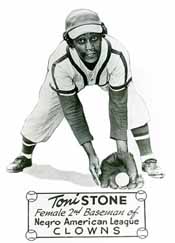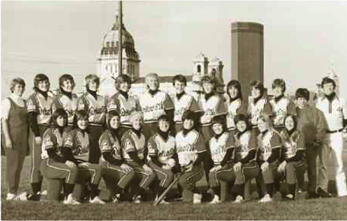Difference between revisions of "Avantis Softball Team"
| Line 1: | Line 1: | ||
<div style="text-align: center;"> | <div style="text-align: center;"> | ||
| − | '''Dunning Field, St. Paul, MN''' | + | '''Dunning Field, St. Paul, MN (1960-1975?)''' |
</div> | </div> | ||
Latest revision as of 21:49, 26 March 2010
Dunning Field, St. Paul, MN (1960-1975?)
| The Avantis pose in front of the Minneapolis skyline, 1975. Note that the IDS Center is the only visible skyscraper. Courtesy of the Minnesota Historical Society and Betty Hawes. |
Though conceptually rooted in Minneapolis, the Avantis all-women softball team represented a greater relationship between queer women and sporting that is evident in the Twin Cities. Indeed, the team interchangeably referred to themselves as the Minneapolis Avantis and the Twin Cities Avantis.
|
| Dunning Field served the Rondo Neighborhood long before Interstate 94 erased it from the map in the 1960s. The neighborhood permitted a handful of talented young girls to participate in softball, baseball, and other sports. Notably, old Rondo was home to Toni Stone, a lifelong “tomboy” who became one of the first African-American women to play baseball professionally.(3) In many ways, Stone blazed a path for the Avantis a decade before the latter organized.
|
 Toni Stone, when she played for the Indianapolis Clowns, Courtesy of the National Baseball Hall of Fame's Library and Deborah Blagg. |
While the Avantis were visibly a queer women’s softball team, they were not vocally so—a second group, The Wilder Ones, became the first openly-queer women’s team in 1971.(6) The later team challenged the Minneapolis Park Board and set a standard for future relations between the City and queer sports teams.(7)
(1)Enke, Anne. Finding the Movement: Sexuality, Contested Space, and Feminist Activism. North Carolina: Duke University Press, 2007. Page 151.
(2)Enke, page 145.
(3)Sward, Susan. "Obituary: Toni Stone." The San Francisco Gate. 11/6/1996.
(4)Enke, page 151.
(5)Enke, page 145.
(6) Enke, page 156.
(7) Enke, page 157.
Part of Minneapolis/St. Paul, MN: 100 Queer Places in Minnesota History, (1860-1969), (1969-2010)
